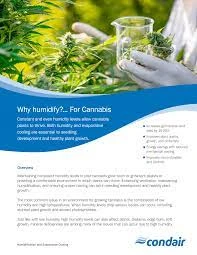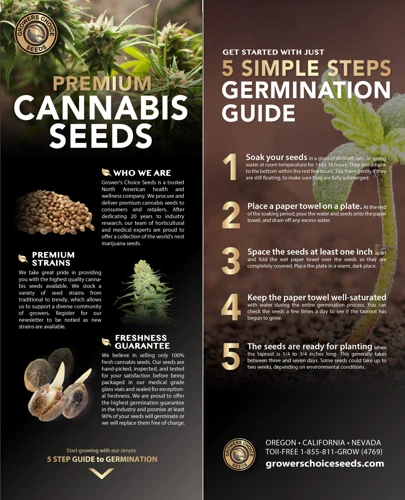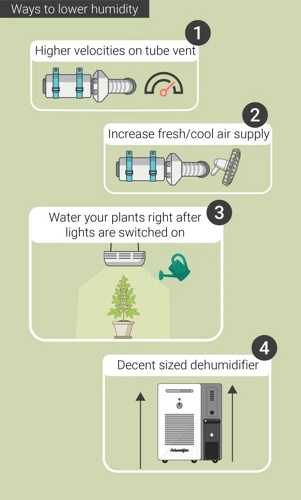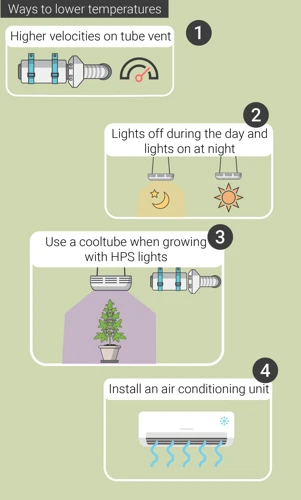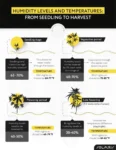
Why Proper Humidity Levels are Crucial for Cannabis Seed Germination
Introduction
Contents
Starting the process of growing your own cannabis plant can be exciting, but it requires attention to detail and proper care to ensure a successful harvest. One important step in the process is cannabis seed germination, which is the process of awakening the seed and beginning the growth of a new plant. However, many growers overlook the critical role that humidity levels play in this process. Ensuring the proper humidity levels are maintained during germination is crucial for the success of your plants. In this article, we will explore the relationship between humidity and germination, the factors that affect humidity levels, and how to ensure proper humidity levels for successful cannabis seed germination.
What is Cannabis Seed Germination?
When it comes to growing cannabis plants, the first step is cannabis seed germination. Germination refers to the process of a seed sprouting and growing into a seedling. During germination, the seed’s embryo begins to expand and break through the protective shell, eventually forming a stem and two leaves.
To better understand the process, take a look at this table that outlines the stages of cannabis seed germination:
| Stage | Description |
|---|---|
| Seed Activation | Soaking the seeds in water to activate enzymes and soften the shell. |
| Taproot Emergence | The seed’s taproot begins to emerge from the shell and grow downward. |
| Seedling Emergence | The stem and two leaves emerge from the soil, allowing the plant to begin photosynthesis. |
Proper germination is crucial for the growth and development of healthy cannabis plants. It ensures that the seedling is able to establish a strong root system and absorb vital nutrients from the soil. In order to achieve successful germination, it’s important to maintain optimal humidity levels and provide adequate conditions for the seedling to thrive.
The Relationship Between Humidity and Germination
When it comes to germinating cannabis seeds, many factors come into play, and humidity is one of the most important ones. The level of moisture in the air can significantly affect the germination process and the overall success of growing healthy plants. But what is the relationship between humidity and germination, and how do humidity levels impact the seeds? In this section, we will explore the intricate correlation between humidity and germination, the optimal humidity levels needed, as well as the effects of both high and low humidity levels.
Optimal Humidity Levels for Germination
For successful cannabis seed germination, it’s crucial to maintain proper humidity levels. The optimal humidity level for cannabis seed germination is between 70% and 90%. At this level, the seeds can absorb enough water to initiate the germination process without becoming oversaturated and potentially drowning.
However, it’s important to note that maintaining high humidity levels above 90% can lead to several issues, including fungal growth and mold. High humidity levels can also cause poor root development and stunted growth in the seedlings. On the other hand, low humidity levels below 70% can cause the seeds to dry out and become unviable for germination.
To ensure that the seeds get the proper amount of moisture during germination, it’s important to monitor and adjust the humidity levels as needed. Maintaining proper humidity levels during the germination process can also help speed up the process and increase overall germination rates.
Here is a list of optimal humidity levels for cannabis seed germination:
- Optimal humidity level: 70% – 90%
- Too high humidity level: Above 90%
- Too low humidity level: Below 70%
By keeping the humidity levels within this range, growers can help give their cannabis seeds the best possible chance for successful germination and growth.
Effects of High Humidity Levels
High humidity levels during cannabis seed germination can have detrimental effects on the success of the process. Here are some of the ways in which high humidity can negatively affect the germination process:
- Fungal growth: High humidity levels can create a perfect breeding ground for mold and fungi. This can lead to the growth of harmful fungi such as pythium and fusarium, which can cause damping off in seedlings.
- Risk of overwatering: High humidity levels can also increase the likelihood of overwatering. This is because excess moisture can accumulate in the growing medium and cause the roots to become waterlogged, which can lead to root rot and stunted growth.
- Slow germination: In some cases, high humidity levels can actually slow germination. This is because excess moisture can prevent the seed from absorbing oxygen, which is necessary for healthy germination.
It is important to maintain optimal humidity levels during cannabis seed germination to avoid these negative effects and ensure the success of the germination process.
Effects of Low Humidity Levels
When it comes to cannabis seed germination, low humidity levels can also have a negative impact. Here are some of the effects of low humidity on the germination process:
| Effect | Description |
|---|---|
| Poor Seed Performance | Low humidity levels can cause the cannabis seeds to dry out, which can lead to poor germination rates. The seeds may take longer to sprout, and the resulting plants may be weak and stunted. |
| Increased Risk of Contamination | When the humidity is too low, the germination medium can become too dry, which can create a breeding ground for harmful bacteria and fungi. This can increase the risk of contamination and reduce the overall success rate of the germination process. |
| Increased Need for Watering | With low humidity levels, the germination medium can quickly dry out, which means that the cannabis seeds will need to be watered more frequently. However, overwatering can lead to root rot, so it’s important to strike the right balance. |
| Stunted Growth | Even if the cannabis seeds do manage to sprout with low humidity levels, the resulting plants may be stunted in their growth. This can result in smaller yields and a lower quality end product. |
It’s important to maintain an optimal humidity level during the seed germination process to ensure the best chances of success.
Factors That Affect Humidity Levels During Germination
The success of cannabis seed germination is greatly influenced by various factors that affect the environment in which the seeds are placed. Among these, maintaining proper humidity levels is crucial for ensuring the seeds’ development into healthy, mature plants. Several aspects can impact humidity levels during germination, from the watering techniques used to the containers and coverings employed. Understanding the effects of high and low humidity levels is crucial to establishing optimal conditions for the germination process. Let’s take a closer look at these factors and learn how they affect cannabis seed germination.
Watering Techniques
Proper watering techniques play a crucial role in maintaining the optimal humidity levels required for cannabis seed germination. Overwatering or underwatering can disrupt the balance of moisture needed for successful germination. Here are some essential tips for watering during germination:
- Use a spray bottle: Spraying the surface of the soil or growing medium with a fine mist is an effective way to ensure even moisture distribution without oversaturating the soil.
- Avoid direct watering: Pouring water directly onto the seeds can displace the fine particles of soil, making it hard for the seedling to break through the surface.
- Water regularly: Consistent watering is crucial to maintaining the proper humidity levels needed for seed germination. But be careful not to overwater, as this can lead to rot or mold.
- Check moisture level: Use your hands to feel the moisture level of the soil or grow medium. If it feels dry, it’s time to water. If it feels moist, hold off on watering.
- Avoid standing water: Ensure proper drainage by using containers with drainage holes, or placing a layer of rocks at the bottom of the container to allow water to drain away from the seeds.
By following these watering techniques, you’ll be able to maintain the proper moisture levels for successful cannabis seed germination. However, it’s important to note that the amount and frequency of watering may vary depending on factors such as the type of soil, container, and growing environment. Regularly checking the moisture level and adjusting your watering practices accordingly will ensure the best results.
Containers and Coverings
The containers and coverings used during cannabis seed germination can also affect the humidity levels. Proper drainage is key to avoid water buildup, which can lead to mold growth and other problems. Using perforated containers or containers with drainage holes can help prevent excessive moisture buildup.
Additionally, the type of covering used can also impact humidity levels. A covering is typically used to help retain moisture and ensure a stable environment for seed germination. One common option is plastic wrap, which can be placed over the top of the container to create a greenhouse-like environment. However, it’s important to make sure that the plastic wrap is not completely airtight, as this can lead to excess moisture and mold growth.
Another option is to use a commercial humidity dome or dome lid, which is designed specifically for seed germination. These domes usually have built-in vents to allow for proper air exchange.
Plus, using proper labels is also important. A waterproof label is necessary to prevent the ink from running and polluting the germination media.
It’s important to regularly check on the containers and coverings to ensure that the humidity levels are stable and at the optimal level for cannabis seed germination.
How to Ensure Proper Humidity Levels for Germination
Maintaining the appropriate humidity levels is crucial when it comes to successful cannabis seed germination. However, achieving and maintaining the ideal moisture content in the air can be challenging for many growers, especially those who are new to the process. In this next section, we will explore different techniques and methods that can help you ensure proper humidity levels during the germination process. Let’s take a closer look at some of the tips and tricks you can implement to help your cannabis seeds grow into healthy and robust plants.
Using a Humidity Dome
One effective way to ensure proper humidity levels during cannabis seed germination is by using a humidity dome. A humidity dome is a clear plastic covering that is placed over the container holding the seeds. Its purpose is to create a greenhouse-like environment that mimics the ideal conditions for germination.
The humidity dome is beneficial because it helps to regulate moisture levels and prevent the seeds from drying out. The dome also helps to maintain a consistent temperature and protect the seeds from any sudden temperature changes or drafts.
To use a humidity dome, follow these steps:
| Step | Description |
|---|---|
| Step 1 | Fill your container with your chosen growing medium and water it until the soil is moist but not soaking wet. |
| Step 2 | Place your cannabis seeds on top of the soil, spacing them out evenly. |
| Step 3 | Cover the container with the humidity dome, making sure it’s securely in place. |
| Step 4 | Place the container in a warm, dark area, such as a closet or cupboard, for the first few days. |
| Step 5 | After a few days, you should start to see the first signs of germination. At this point, you can move the container to a location with more light, but still maintain the humidity dome. |
| Step 6 | As the seedlings grow, gradually lift the humidity dome to increase air circulation and reduce humidity levels. |
It’s important to note that the humidity dome should only be used during the germination process and not during the entire growing cycle. Once the seedlings have established themselves and are growing well, the humidity dome can be removed to prevent mold and fungus from forming.
Using a humidity dome is a simple yet effective way to ensure proper humidity levels for cannabis seed germination. It’s an affordable and accessible tool for both beginner and experienced growers, and can greatly increase the chances of successful germination.
Using a Humidifier
A humidifier can be a convenient way to regulate humidity levels for cannabis seed germination. Here are some tips for using a humidifier effectively:
- Choose the right type of humidifier: There are several types of humidifiers on the market, including ultrasonic humidifiers, evaporative humidifiers, and steam humidifiers. While each type has its own advantages and disadvantages, for cannabis seed germination, it’s often best to choose an ultrasonic humidifier. These humidifiers use high-frequency vibrations to create a fine mist, which makes them less likely to create excess moisture that could lead to mold or other problems.
- Position the humidifier: Depending on the size and layout of your germination area, you may need to position the humidifier strategically to ensure even moisture distribution. For example, if you’re using a small grow tent, you may want to place the humidifier close to the seedlings, but not directly over them.
- Choose the right setting: Most humidifiers allow you to adjust the level of humidity they produce. For cannabis seed germination, you’ll generally want to set the humidifier to around 70-80% relative humidity. Check the manufacturer’s instructions for specific recommendations.
- Check the water: The quality of the water you use in your humidifier can affect its effectiveness and longevity. Ideally, you should use distilled water or water that has been treated with a reverse osmosis system. This will help prevent mineral buildup that can clog the humidifier and reduce its efficiency.
Remember, using a humidifier is just one way to regulate humidity levels for cannabis seed germination. It’s important to monitor humidity levels regularly and adjust your methods as necessary to ensure that your seeds have the best possible chance of germinating successfully.
Maintaining Proper Airflow
Proper airflow is crucial in ensuring the right humidity levels for cannabis seed germination. Without it, the humidity levels can become stagnant and promote the growth of mold and other harmful bacteria which can damage or even kill your seeds. Here are some tips on how to maintain proper airflow during the germination process:
1. Avoid Overcrowding: Overcrowding the germination area can lead to poor airflow. Ensure that the seeds are spaced out properly, and there is enough space between containers for air to circulate around them.
2. Use A Fan: The use of a small fan can help promote airflow around the germination area. It also helps reduce humidity levels and prevent stagnant air around the plants.
3. Proper Ventilation: Ensure that there is proper ventilation in the germination area. Open a window or use an exhaust fan to circulate fresh air, and reduce humidity levels which can lead to poor airflow.
4. Strategic Placement: Proper placement of the containers can also help maintain proper airflow. Ensure that the containers are not placed too close to walls or other obstructions preventing proper air circulation.
5. Periodically Remove Coverings: If using a humidity dome, ensure you remove it periodically to allow for proper airflow throughout the germination period.
By maintaining proper airflow, you’ll reduce the risk of mold growth and increase the chances of successful germination. Don’t neglect this aspect when germinating seeds, and don’t overcrowd the germination area. Provide fresh air by opening a window, strategically place containers and use a small fan if necessary.
Regular Monitoring and Adjustment
Regular monitoring and adjustment are key to ensuring proper humidity levels during cannabis seed germination. Here are some tips for keeping an eye on humidity levels and adjusting as needed:
- Check humidity levels daily: Use a hygrometer to measure the humidity levels in your growing area at least once a day. This will help you identify any changes or fluctuations in humidity that may need to be addressed.
- Adjust as needed: If humidity levels are too low, consider misting your plants or using a humidifier to increase moisture in the air. If humidity levels are too high, consider increasing airflow by opening vents or doors or using a dehumidifier to remove excess moisture from the air.
- Monitor moisture levels in the soil: In addition to monitoring humidity levels in the air, it’s important to keep an eye on moisture levels in the soil. Make sure the soil stays moist but not soaked, as overly wet soil can lead to mold or other problems.
- Keep a log: Keeping a record of humidity levels and adjustments can help you identify patterns and make informed decisions about how to manage humidity levels in the future.
Remember, maintaining proper humidity levels is just one piece of the puzzle when it comes to successful cannabis seed germination. By regularly monitoring and adjusting humidity levels, you can help ensure that your seeds have the moisture they need to germinate successfully and grow into healthy, robust plants.
Other Tips for Successful Seed Germination
Successfully germinating cannabis seeds can be a tricky process that requires careful consideration and attention to detail. In addition to maintaining proper humidity levels, there are several other factors that can significantly impact the outcome of your efforts. With the right techniques and practices, however, you can greatly increase your chances of successfully germinating your cannabis seeds and achieving a healthy, thriving crop. In this section, we’ll explore some additional tips and best practices for successful seed germination that can help ensure a healthy, bountiful harvest.
Using Quality Seeds
When it comes to cannabis seed germination, one of the most important factors to consider is the quality of the seeds used. Using high-quality seeds is essential to ensure that your plants will grow healthy and strong. Here are some features that indicate quality seeds:
| Feature | Description |
|---|---|
| Size and Appearance | High-quality seeds are usually larger in size, with a smooth and unblemished surface. They should also have a uniform color and shape, without any cracks or other visible defects. |
| Freshness | The fresher the seeds, the better they will germinate. Look for seeds that have been recently harvested, and avoid ones that have been stored for too long. |
| Durability | Good-quality seeds are able to withstand the process of germination and grow into healthy plants. Avoid seeds that are damaged, crushed or appear to be weak. |
| Genetics | The genetics of the seeds have a significant impact on the quality of the plant that grows from them. Look for seeds produced by reputable breeders with a track record of producing high-quality strains. |
| Germination Rate | Reputable seed banks will provide germination rates for their seeds, indicating the percentage of seeds that will sprout. Look for seeds with a high germination rate to help ensure successful growth. |
By using high-quality seeds, you can increase the chances of a successful germination and ensure that your plants will grow to their full potential. Remember to do your research and purchase from a reputable seed bank to obtain the best possible seeds for your cannabis garden.
Choosing the Right Growing Medium
When it comes to cannabis seed germination, selecting the right growing medium is crucial to ensuring successful and healthy growth of your plants. The growing medium not only provides a physical support system for the roots but also serves as a source of nutrients and water for your plants. There are several types of growing mediums available, each with its own advantages and disadvantages.
Soil: Soil is a popular choice for many cannabis growers due to its affordability and ease of use. It provides a stable and porous medium for roots to grow and also contains many essential nutrients required for plant growth. However, soil may require additional amendments to accommodate certain strains’ specific needs, and excess moisture retention can lead to fungal growth and root rot. Additionally, soil can be heavy and challenging to move.
Coco Coir: Coco coir is an increasingly popular alternative growing medium made from coconut husks. It is known for its excellent water retention capabilities, providing a hydroponic-like growing environment in a soil-like medium. Coco coir is also pH-neutral, so it eliminates the need for any pH adjustment. However, it requires specific watering routines and can be challenging to rehydrate.
Rockwool: Rockwool is a soilless growing medium made from spun volcanic rock that provides ample support for roots and excellent drainage. It comes in different sizes and shapes, allowing for customizability to fit growing needs. However, rockwool is an inorganic growing medium and requires additional nutrients.
Peat Moss: Peat moss is another natural option that provides excellent water retention and aeration for rooting. It is also often pre-fertilized and neutral pH, so it can be quickly used right out of the bag. However, the peat moss industry is criticized for its unsustainable harvesting practices and environmental impact.
Ultimately, the choice of growing medium depends on the grower’s preferences, resources, and the specific requirements of the cannabis strain. It is important to do research and choose a high-quality growing medium that is free from contaminants and supports healthy growth.
Providing Adequate Light and Heat
When it comes to germinating cannabis seeds, providing adequate light and heat is crucial for successful growth. Without the proper amount of both, seeds may not germinate at all or may grow abnormally.
Light is essential for stimulating plant growth, and cannabis seeds require a specific amount of light to germinate properly. This is typically in the form of fluorescent lights or grow lights, which can be set up to provide the optimal amount of light.
Heat is also crucial, as cannabis seeds require a specific temperature range to germinate. Generally, a temperature range of 70-85°F (21-29°C) is ideal for seed germination. Use a heat mat or other heating device to provide consistent warmth to the seeds.
Here is a table summarizing the optimal conditions for cannabis seed germination:
| Factor | Optimal Range |
|---|---|
| Light | Fluorescent lights or grow lights |
| Temperature | 70-85°F (21-29°C) |
It is important to monitor both the light and heat levels during the germination process and make adjustments as needed. By providing the proper light and heat conditions, you can ensure that your cannabis seeds have the best chance of germinating successfully and growing into healthy plants.
Conclusion
In conclusion, it is crucial to maintain proper humidity levels during the cannabis seed germination process. Optimal humidity levels promote successful germination and healthy growth of the seedlings. High humidity levels can lead to mold and mildew growth, while low humidity levels can cause the seeds to dry out and fail to sprout.
Several factors affect humidity levels during germination, such as watering techniques and the choice of containers and coverings. It is important to choose a suitable method of maintaining humidity, such as using a humidity dome or a humidifier, and ensuring proper airflow.
In addition to controlling humidity levels, there are other tips that can help with successful seed germination. Choosing quality seeds, selecting the right growing medium, and providing adequate light and heat are all important factors to consider.
Overall, taking the time and effort to establish and maintain proper humidity levels during cannabis seed germination can lead to increased success and healthier plants. By understanding the relationship between humidity and seed germination, and implementing the necessary steps for control and monitoring, growers can ensure a successful start to their cannabis growing journey.
Frequently Asked Questions
What is the best temperature for cannabis seed germination?
The optimal temperature for cannabis seed germination is between 70-85°F (21-29°C).
Can I use tap water for seed germination?
It’s recommended to use distilled or purified water to avoid any contaminants that can harm the seeds.
How long does cannabis seed germination take?
Germination typically takes 1-7 days, depending on the strain and environmental factors.
Do I need to keep the seeds in complete darkness during germination?
No, you can keep them in low light conditions, but avoid direct sunlight as it can dry them out.
What is a humidity dome and how does it help with germination?
A humidity dome is a cover that traps moisture and helps maintain high humidity levels, which is essential for successful germination.
How often should I water the seeds during germination?
You should water the seeds whenever the top of the soil feels dry. Over-watering can drown the seeds and lead to rot.
Can I use a heating mat to raise the temperature during germination?
Yes, a heating mat placed under the seed tray can help maintain optimal temperature for germination.
Can I germinate cannabis seeds directly in soil?
Yes, but it’s important to make sure the soil is moist and well-draining to ensure proper germination.
Should I remove the seeds from the humidity dome once they have sprouted?
Yes, once the seeds have sprouted and developed their first set of leaves, it’s time to remove the humidity dome to prevent excessive moisture buildup.
Why is proper humidity level so important for successful seed germination?
Proper humidity levels ensure the seeds receive the moisture they need to sprout without becoming too damp or dry. It also plays a key role in the overall health and development of the plants.

